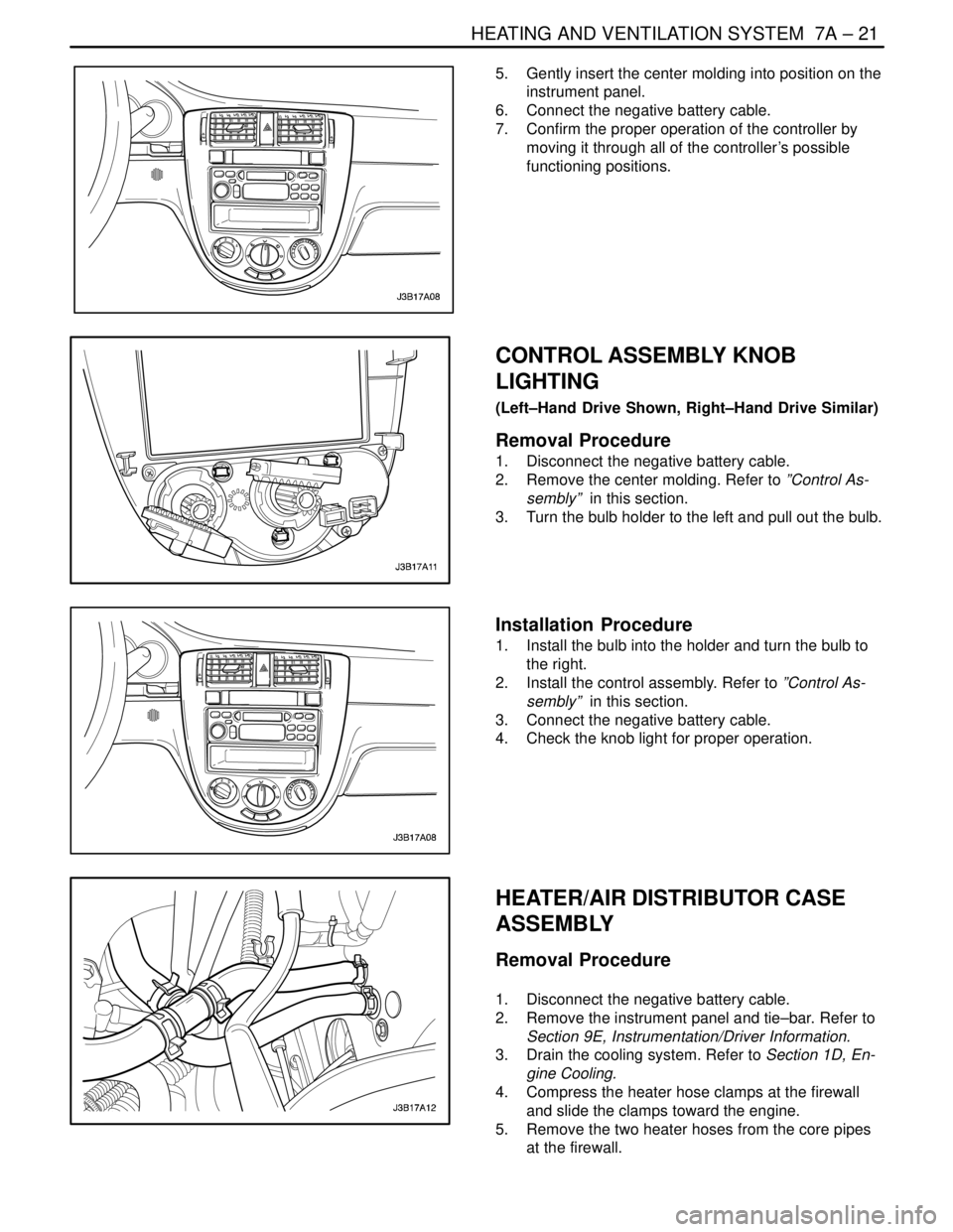2004 DAEWOO NUBIRA check engine
[x] Cancel search: check enginePage 1983 of 2643

HEATING AND VENTILATION SYSTEM 7A – 9
DAEWOO V–121 BL4
StepNo Yes Value(s) Action
341. Set the blower on maximum speed.
2. Rotate the temperature control from full hot to
full cold.
3. Listen for an airflow change.
Does the airflow change?–Go to Step 35Go to Step 36
351. Check the following aspects of the temperature
door:
S Travel.
S Cables.
S Linkage.
S Control.
2. Verify the accuracy of the temperature control
at full hot.
Is the repair complete?–Go to Step 1–
361. Check the system for any obstruction between
the blower and the system outlets.
2. Remove any obstruction.
Is the repair complete?–Go to Step 1–
BLOWER ELECTRICAL
StepActionValue(s)YesNo
1Verify the customer’s complaint.
Are the customer’s concerns verified?–Go to Step 2System OK
2Turn the blower ON.
Does the blower run at any speed?–Go to Step 14Go to Step 3
31. Disconnect the power connector from the blow-
er motor under the dashboard on the passen-
ger side of the vehicle.
2. Turn the ignition ON.
3. Turn the blower ON.
4. Test for voltage on the connector. The terminal
connected to the violet wire is positive and the
terminal connected to the black wire is nega-
tive.
Is this voltage present?11–14vGo to Step 4Go to Step 5
4Replace the blower motor.
Is the repair complete?–System OK–
5Check fuse F7 in the I/P fuse block in the engine fuse
block.
Is the fuse blown?–Go to Step 6Go to Step 7
61. Turn the ignition ON.
2. Use a short detector to locate a possible short
in the following locations:
S Fuse panel–to–blower speed switch.
S Blower speed switch–to–heater resistor
block.
S Heater resistor block–to–blower motor.
S Blower speed switch–to–blower HI relay.
3. Repair any short.
4. Replace any blown fuse.
Is the repair complete?–System OK–
Page 1984 of 2643

7A – 10IHEATING AND VENTILATION SYSTEM
DAEWOO V–121 BL4
StepNo Yes Value(s) Action
71. Turn the ignition ON.
2. Set the blower switch on 4.
3. Check the blower motor ground.
Is ground OK?–Go to Step 9Go to Step 8
8Repair the blower motor ground.
Is the repair complete?–System OK–
9Check the motor connector with a 12–volt test light.
Does the test light come on?–Go to Step 10Go to Step 11
10Repair the open in the feed wire from the resistor
block to the blower motor.
Is the repair complete?–System OK–
11Use the 12–volt test light to check the power feed
terminal on the blower speed switch.
Does the light come on?–Go to Step 12Go to Step 13
12Replace the blower speed switch.
Is the repair complete?–System OK–
13Repair the open in the power wire from the blower
speed switch to the fuse panel.
Is the repair complete?–System OK–
14Turn the blower on speed 4.
Does the blower fail to operate at speed 4?–Go to Step 15Go to Step 21
15Check fuse EF3 in the engine fuse block.
Is the fuse blown?–Go to Step 16Go to Step 17
161. Turn the ignition ON.
2. Turn the blower motor switch to 4.
3. Use a short detector to locate a possible short
in the following locations:
S Engine fuse panel–to–blower HI relay.
S Blower HI relay–to–blower motor.
4. Repair any short.
5. Replace the EF3 fuse.
Is the repair complete?–System OK–
171. Turn the ignition switch ON.
2. Set the blower switch to 4.
3. Check for 12 volts on the blower HI relay coil
terminal from the blower speed switch terminal
A7.
Is this voltage present?–Go to Step 18Go to Step 19
18Replace the blower speed switch.
Is the repair complete?–System OK–
191. Turn the ignition OFF.
2. Check for opens in the following locations:
S EF3 fuse–to–blower HI relay.
S Blower speed switch–to–blower– HI relay.
S Blower HI relay–to–ground.
S Blower HI relay–to–blower motor.
3. Repair any opens.
Is the repair complete?–System OKGo to Step 20
20Replace the blower HI relay.
Is the repair complete?–System OK–
Page 1985 of 2643

HEATING AND VENTILATION SYSTEM 7A – 11
DAEWOO V–121 BL4
StepNo Yes Value(s) Action
211. Disconnect the resistor block connector.
2. Connect one lead of a self–powered test light
to any single lead on the resistor block. Use
the other lead to probe each of the other two
terminals.
Does the test light illuminate on all terminals?–Go to Step 23Go to Step 22
22Replace the resistor block.
Is the repair complete?–System OK–
231. Turn the ignition to LOCK.
2. Disconnect the connector from the resistor
block.
3. Connect a jumper lead from the positive termi-
nal on the battery to any wire terminal in the
connector.
4. Use a 12–volt test light to check for voltage
from the corresponding wire on the blower
speed switch.
5. Repeat the same test on the other wires.
Does the lamp light on all three wires?–Go to Step 25Go to Step 24
24Replace the blower speed switch.
Is the repair complete?–System OK–
25Repair the open in the affected wire.
Is the repair complete?–System OK–
IMPROPER AIR DELIVERY OR NO MODE SHIFT
This procedure provides a test of all functions of the heater/defroster unit.
1. Warm up the vehicle.
2. Keep the engine running.
3. Perform the tests outlined in the table below and look for the results indicated.
CONTROL SETTINGS
CORRECT RESULTS
Mode
KnobTe m p
Contro
lBlower
Motor
SwitchBlower
SpeedPower
Vent
OutletFloor
OutletDefrost
OutletSide
Window
Outlet
VentColdOffOffNo
AirflowNo
AirflowNo
AirflowNo
Airflow
VentCold4HighAmbient
AirflowNo
AirflowNo
AirflowNo
Airflow
FloorCold to
Hot4HighNo
AirflowCold to Hot
AirflowMinimum
Cold to Hot
AirflowMinimum
Cold to Hot
Airflow
De-
frosterCold to
Hot4HighNo
AirflowMinimum
Cold to Hot
AirflowCold to Hot
AirflowMinimum
Cold to Hot
Airflow
If any of these settings does not produce the correct results, perform the following diagnostic procedure.
Page 1986 of 2643

7A – 12IHEATING AND VENTILATION SYSTEM
DAEWOO V–121 BL4
StepActionValue(s)YesNo
1Verify the customer’s complaint.
Are the customer’s concerns verified?Go to Step 2System OK
2S Examine the affected door in the unit for proper
attachment to the vacuum actuator.
S Check the actuator connection to the door.
S Check that the vacuum hose is properly con-
nected.
Is everything connected properly?–Go to Step 4Go to Step 3
3Repair as necessary.
Is the repair complete?–System OK–
41. Disconnect the actuator at the door.
2. Check the range of the door travel and the ef-
fort required to move it.
Does the door move freely through its entire range
of travel so that it can close at both ends of the
range?–Go to Step 5Go to Step 3
5Check the travel of the actuator by turning the con-
trol knob with the engine running.
Is the actuator travel OK?–Go to Step 6Go to Step 7
61. Reinstall the actuator.
2. Recheck the system using the ”Control Set-
tings/Correct Results” tests in this procedure.
Does the system perform properly?–System OKGo to Step 9
71. Check the vacuum hose at the control.
2. Check for a broken control.
Is there a problem with the vacuum hose or the con-
trol?–Go to Step 8Go to Step 9
8Repair the vacuum hose or the control as necessary.
Is the repair complete?–System OKGo to Step 9
9Recheck the system using the ”Control Settings/
Correct Results” tests in this procedure.
Is the repair complete?–System OKGo to Step 10
10Check for airflow from the defroster or the vent out-
lets.
Is there high airflow from the defroster or the vent
outlets?–Go to Step 11Go to Step 12
11Adjust the heater door at the floor and the vent door
to get the proper airflow.
Is the repair complete?–System OK–
12Switch the mode knob to defrost.
Is the defroster airflow OK?–Go to Step 13Go to Step 14
131. Remove the heater outlet.
2. Check the heater outlet for obstructions.
3. Remove any obstructions in the heater outlet.
Is the repair complete?–System OK–
14Check the blower speeds for change in the airflow.
Does the blower speed increase as the control is
turned from 1 to 4?–Go to Step 15Go to ”Blower
Electrical
(Manual and
Non–A/C)”
Page 1988 of 2643

7A – 14IHEATING AND VENTILATION SYSTEM
DAEWOO V–121 BL4
StepNo Yes Value(s) Action
71. Check the temperature door travel, the cable,
and the linkage.
2. Adjust to full cold.
3. Check for full hot.
Is the repair complete?–System OK–
8Adjust or repair the floor/defroster and/or the vent/
floor mode.
Is the repair complete?–System OK–
9In the vent position, is the problem objectionable
bleed?–Go to Step 10Go to Step 15
101. Check the system case for leaks.
2. Check the floor outlet attachment.
Are there problems?–Go to Step 11Go to Step 12
11Repair the system case or the floor outlet attach-
ment as required.
Is the repair complete?–System OKGo to Step 12
121. Turn the ignition switch OFF.
2. Turn the temperature control knob to full hot,
then rapidly to full cold.
Do you hear the door slam just before you reach the
end of the control travel?–Go to Step 13Go to Step 14
13Adjust the vent door to vent more.
Is the repair complete?–System OK–
141. Check the temperature door travel, the cables,
and the linkage.
2. Verify that the temperature door goes to full
cold.
3. Check the temperature door for full hot.
Is the temperature door travel correct?–System OK–
151. Set the fresh air/recirculating air control to
fresh air (indicator lamp off).
2. Set the temperature control to full cold.
3. Start the vehicle and allow the engine to warm
up.
4. Measure the air temperature at the blower in-
let, or cowl, and at the vent air outlet inside the
vehicle.
Is the outlet air more than 5°C (41°F) warmer than
the inlet air?–Go to Step 16System OK
161. Check for hot air leaks from the engine
compartment to the blower inlet.
2. Repair, as needed.
Is the repair complete?–System OK–
Page 1990 of 2643

7A – 16IHEATING AND VENTILATION SYSTEM
DAEWOO V–121 BL4
BLOWER NOISE
StepActionValue(s)YesNo
1Verify the customer’s complaint.
Are the customer’s concerns verified?–Go to Step 2System OK
21. Sit inside the vehicle.
2. Close the doors and the windows.
3. Turn the ignition ON.
4. Start the engine.
5. Set the temperature to full cold.
6. Cycle through the blower speeds, the modes,
and the temperature settings in order to find
the noise.
Is the blower noise constant at high blower speeds
or certain modes, but absent at lower speeds or in
other modes?–Go to Step 11Go to Step 3
3Check for vibrations from the blower motor and fan
assembly at each blower speed by feeling the blower
motor housing.
Did you find excessive vibration?–Go to Step 6Go to Step 4
41. Remove the blower motor and the fan assem-
bly. Refer to ”Blower Motor” in this section.
2. Check for foreign material at the opening of the
blower inlet.
Do you find any foreign material at the blower inlet?–Go to Step 5Go to Step 6
5Remove all foreign material.
Is the repair complete?–System OKGo to Step 6
61. Examine the blower fan for wear spots,
cracked blades, a cracked hub, a loose fan re-
taining nut, or bad alignment.
2. Examine the blower case for wear spots.
Did you find any problem?–Go to Step 7Go to Step 9
7Repair as required.
Is the repair complete?–System OKGo to Step 8
8Replace the motor and the fan assembly.
Is the repair complete?–System OKGo to Step 9
9If the noise is a click/tick or whine, replace the motor.
Is the repair complete?–System OKGo to Step 10
10Reinstall the original motor.
Is the problem still present?–Go to Step 11System OK
111. Set the blower speed on maximum.
2. Check full–hot to full–cold temperature posi-
tions in the defrost, floor, and vent modes.
Is the noise present in the defrost mode only?–Go to Step 12Go to Step 13
121. Check the ducts for obstructions or foreign ma-
terials.
2. Remove any obstructions or foreign materials.
3. Check the floor/defroster door seals.
4. Repair or replace the components, as needed.
Is the repair complete?–System OK–
13Is the noise present in the floor mode only?–Go to Step 12Go to Step 14
14Is the noise present in the vent mode only?–Go to Step 15Go to Step 16
Page 1995 of 2643

HEATING AND VENTILATION SYSTEM 7A – 21
DAEWOO V–121 BL4
5. Gently insert the center molding into position on the
instrument panel.
6. Connect the negative battery cable.
7. Confirm the proper operation of the controller by
moving it through all of the controller’s possible
functioning positions.
CONTROL ASSEMBLY KNOB
LIGHTING
(Left–Hand Drive Shown, Right–Hand Drive Similar)
Removal Procedure
1. Disconnect the negative battery cable.
2. Remove the center molding. Refer to ”Control As-
sembly” in this section.
3. Turn the bulb holder to the left and pull out the bulb.
Installation Procedure
1. Install the bulb into the holder and turn the bulb to
the right.
2. Install the control assembly. Refer to ”Control As-
sembly” in this section.
3. Connect the negative battery cable.
4. Check the knob light for proper operation.
HEATER/AIR DISTRIBUTOR CASE
ASSEMBLY
Removal Procedure
1. Disconnect the negative battery cable.
2. Remove the instrument panel and tie–bar. Refer to
Section 9E, Instrumentation/Driver Information.
3. Drain the cooling system. Refer to Section 1D, En-
gine Cooling.
4. Compress the heater hose clamps at the firewall
and slide the clamps toward the engine.
5. Remove the two heater hoses from the core pipes
at the firewall.
Page 2010 of 2643

7B – 8IMANUAL CONTROL HEATING, VENTILATION AND AIR CONDITIONING SYSTEM
DAEWOO V–121 BL4
DIAGNOSIS
GENERAL DIAGNOSIS
TESTING THE REFRIGERANT
SYSTEM
If you suspect a problem in the refrigerant system, check
for the following conditions:
1. Check the outer surfaces of the radiator and the
condenser cores to be sure that the airflow is not
blocked by dirt, leaves, or other foreign material.
Check between the condenser and the radiator, as
well as all outer surfaces.
2. Check for restrictions or kinks in the condenser
core, the hoses, and the tubes.
3. Check the operation of the blower fan.
4. Check all the air ducts for leaks or restrictions. Low
airflow rate may indicate a restricted evaporator
core.
5. Check for slippage of the compressor clutch.
6. Check the drive belt tension.
INSUFFICIENT COOLING ”QUICK
CHECK” PROCEDURE
Perform the following ”hand–feel” procedure to get a quick
idea of whether the A/C system has the proper charge of
Refrigerant–134a. The air temperature must be above
21°C (70°F) for most models.
1. Warm up engine. Run the engine at idle.
2. Open the hood and all the doors.
3. Turn the A/C switch ON.
4. Set the temperature control to the full cold position.
5. Set the blower speed switch on the maximum
speed setting.
6. ”Hand–feel” the temperature of the evaporator out-
let pipe. The pipe should be cold.
7. Check for other problems. Refer to ”Testing the Re-
frigerant System” in this section.
8. Leak check the system. Refer to ”Leak Testing the
Refrigerant System” in this section. If you find a
leak, discharge the system and repair the leak as
required. After completing the repair, evacuate the
system and charge it.
9. If there is no leak, refer to ”Insufficient Cooling
Diagnosis” in this section.